![]()
![]()
![]()
Use LEFT and RIGHT arrow keys to navigate between flashcards;
Use UP and DOWN arrow keys to flip the card;
H to show hint;
A reads text to speech;
40 Cards in this Set
- Front
- Back
|
Igneous Texture
|
Texture is the overall appearance of a rock based on the size, shape, and arrangement of interlocking minerals.
Factors affecting crystal size: - Rate of cooling * Slow rate = fewer but larger crystals * Fast rate = many small crystals * Very fast rate forms glass. |
|
|
Volcanic Glass Formation
|
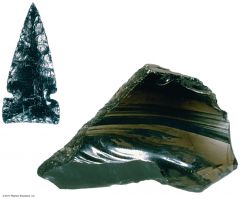
- Molten rock ejected into atmosphere
- Cools very rapidly - Unordered Ion frozen in place before forming orderly crystal structure - Obsidian is prime example |
|
|
Aphanitic (Fine-Grained) Texture
|
- Rapid rate of cooling
- Microscopic crystals - May contain vesicles (holes from gas bubbles) |
|
|
Phaneritic (Coarse-Grained) Texture
|
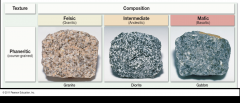
- Slow cooling
- Large, visible crystals roughly equal in size - Felsic, Intermediate, or Mafic |
|
|
Porphyritic Texture
|
- Minerals form at different temperatures.
- Large crystals (phenocrysts) are embedded in a matrix of smaller crystals (groundmass). |
|
|
Pyroclastic Texture
|
- Fragmental appearance produced by violent volcanic eruptions
- Often appear more similar to sedimentary rocks |
|
|
Pegmatitic Texture
|

- Exceptionally coarse-grained
- Form in late stages of crystallization of granitic magmas |
|
|
Vesicular Texture
|
Voids Left by Gas Bubbles
|
|
|
Igneous Relations
|
Aphanitic --> Phaneritic
---------------------------------- Rhyolite ----> Granite Andesite ---> Diorite Basalt--------> Gabbro |
|
|
Know How The Igneous Rocks Form
|
Intrusive
Extrusive |
|
|
Bowens Reaction Series
|
- Minerals crystallize in a systematic fashion based on their melting points.
- During crystallization, the composition of the liquid portion of the magma continually changes. |
|
|
Bowens Reaction Series
(Review Chart in Lab Book) |
Lowest Temperatures to Highest:
Felsic (Granite/Rhyolite) - Lowest Temperature - Potassium Feldspar/ Muscovite/Quartz Intermediate (Diorite/Andesite) - Plagioclase Feldspar/Amphibole/Biotite Mafic(Gabbro/Basalt) - Pyroxene/Plagioclase Feldspar Ultra-Mafic (Peridotite/Komatite) - Olivene |
|
|
Polarizing Microscope
|
The polarizing microscope was originally developed
for investigating crystalline structures within rocks and minerals. |
|
|
Most Abundant Minerals
|
Earth's Mantle
- Olivene Earths Crust - Feldspars |
|
|
Assimilation
|
Incorporating foreign rock into a magma body
|
|
|
Partial Melting
Decompression Melting Flux Melting |
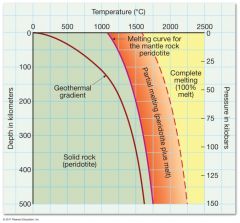
Partial Melting
- The incomplete melting of rock, a process which produces most magma. Decompression Melting - It requires more heat to melt rock at higher pressures and lower heat to melt rock at lower temperatures - When rocks melts as a result of the pressure being reduced it is called decompression melting - Typically occurs along diverging plate boundaries like a mid-ocean ridge Flux Melting - The more water present the lower the melting temperature (Remember Sugar Melting Lab) - Occurs at subduction zones (Converging Plate Boundaries) |
|
|
Magma Mixing
|
Occurs when one magma body intrudes on another magma body having a different composition
|
|
|
Mount Saint Helens
|
?
|
|
|
Hawaiian Lava Flows
|
AA
- Slow moving, Jagged Blocks, Sharp Edges Pahoehoe - Slow Moving, Smooth Surface, Braided Ropes |
|
|
Types of Volcanoes - Cinder Cone
|

- Built from ejected lava (mainly cinder-sized) fragments
- Steep slope angle - Rather small size - Frequently occur in groups |
|
|
Types of Volcanoes - Composite cone (Stratovolcano)
|
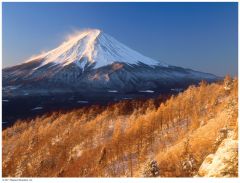
- Most are located adjacent to the Pacific Ocean (e.g., Mount Fujiyama and Mount St. Helens).
- Large, classic-shaped volcano (thousands of feet high and several miles wide at base) - Composed of interbedded lava flows and layers of pyroclastic debris |
|
|
Types of Volcanoes - Shield
|
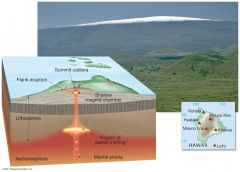
- Broad, slightly dome-shaped
- Composed primarily of basaltic lava - Generally covers large areas - Produced by mild eruptions of large volumes of lava - Mauna Loa in Hawaii is a good example. |
|
|
Viscosity
|
Measure of a material’s resistance to flow (e.g., higher viscosity materials flow with great difficulty).
Factors affecting viscosity 1. Temperature—Hotter magmas are less viscous. 2. Composition—silica (SiO2) content – Higher silica content = higher viscosity (e.g., felsic lava such as rhyolite). - Lower Silica content = lower viscosity or more fluid-like behavior (e.g., mafic lava such as basalt) |
|
|
Factors of Explosive Volcanoes
|
1. Temperature of the magma
2. Composition of the magma - Viscosity 3. Dissolved gases in the magma - Gases expand within a magma as it nears Earth’s surface due to decreasing pressure. - The violence of an eruption is related to how easily gases escape from magma. |
|
|
Types of Eruptions
|
Pyrocastic Flows
- Very fast moving lava flows which are explosive Hawaiian Flows - Slow moving AA and Pahoehoe Lahars: Mudflows - Fast moving mud flows Fissure Eruptions and Lava Plateaus - Fluid basaltic lava extruded from crustal fractures called fissures (e.g., Columbia River plateau) |
|
|
Volcanic Features (Memorize Picture and Fill in Blanks) Page 129
|
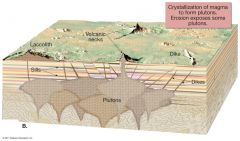
Tabular Intrusive
____________________________________ Dikes - cut across bedding surfaces Sills - run horizontally to bedding surface Massive Intrusive __________________________________________ Lacolith -Similar to a sill. Lens or mushroom-shaped mass. Arches overlying strata upward Batholith - A batholith is a large emplacement of igneous intrusive rock that forms from cooled magma deep in the Earth's crust |
|
|
Volcanic Features (Memorize Picture and Fill in Blanks) Page 129
|
Pluton - Structures that result from the emplacement of magma into preexisting rocks
Volcanic Necks - Pipes are short conduits that connect a magma chamber to the surface |
|
|
The Role of Convection
|
Driving force behind moving plate tectonics. (Lava Lamp Example)
Heat rises and begins cooling near top. Eventually will cool down and sink again. The cycle continues repeatedly. |
|
|
How Sedimentary Rocks Form
|
- Weathering begins the process (Wind, Water) breaks apart particles (Igneous, Metamorphic, and Sedimentary Particles)
- Transported from source location to final resting placing via wind, water, and gravity - Forms layers at final resting place and eventually are lithified by compaction or cementation. |
|
|
How Sedimentary Rocks Classified
|
- Detrital Sedimentary Rocks
*Accumulation of solid particles derived from both mechanical and chemical weathering. - Chemical Sedimentary Rocks * Soluble material produced largely by chemical weathering. * Ion is solution precipitated by inorganic or biologic processes. - Organic Sedimentary Rocks * Coal is primary example --> Formed by remains of plants that have died and accumulated on the floor of a swamps |
|
|
What does grain size tell us?
|
- Help distinguish detrital rocks
- How the particles in the rocks were transported * Larger particles carried by great energy like flood while fine particles are carried by wind like in sand dunes |
|
|
Chemical Formula For Chert and Limestone
|
Limestone
- Compose mostly of calcite (CaCO3) Chert - Composed of Microcrystalline Quartz (SiO2) |
|
|
Sedimentary Cements
|
Cementation is the most important process in which sediments are converted into sedimentary rocks. Most common cements are:
* Calcite - Fizzes on acid test * Iron - Orange/Reddish in Color * Silica - Is the hardest cement |
|
|
What is Lithification?
|
Process in which sediments become sedimentary rocks. Processes include:
* Compaction - sediments accumulate into layers which create enormous weight which compacts the sediments into rocks * Cementation - See Above Card |
|
|
What is Diagenesis?
|
All chemical, physical, and biological processes that take place after sediments are deposited and during and after lithification.
|
|
|
Stages of Coal Formation (Memorize Diagram)
|
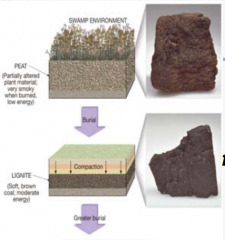
Peat
* A soft brown material in which plant structures are still visible Lignite * Light burial results in light compaction which turns peat into lignite, a soft brown coal |
|
|
Stages of Coal Formation (Memorize Diagram)
|
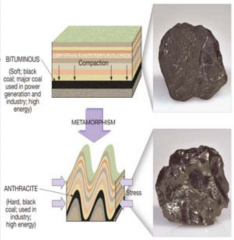
Bituminous
* Deeper burial results in heavier compaction which produces Bituminous Coal Anthracite * Metamorphosed version of bituminous coal which is very hard, black, and shiny. |
|
|
Conglomerate vs Breccia
|
Conglomerate
* Large gravel sized pieces of rounded rock which means it has been weathered Breccia * Large gravel pieces of angular rocks which means that it settled close to its source |
|
|
Environments of Deposition
(Not Enough Info... Too much info to sift through... Sorry!) |
Three Types of Sedimentary Environments:
*Continental * Marine * Transitional (Shoreline) |
|
|
Role of Water Velocity
|
- Fast water velocity results in larger particle sizes.
-Water with no velocity results in fine grained particles that are tough to see with the naked eye. |

